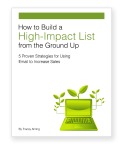Writing Case Studies That Connect
As a copywriter, I’ve seen a lot of case studies that are a little less than, well, inspiring.
Studies that are really not case studies at all, but rather a collection of photos with maybe a word or two of background and a few technical specs thrown in for good measure.
If you’re guilty of this, then you’re certainly not alone.
But there is a better way.
In fact, crafting a truly effective case study really isn’t that difficult. You just need to keep a few things in mind.
What is a case study?
The first thing to remember is not what a case study is, but what a case study is not.
It is not a series of photos tied together with only a few lines of text.
It is not a highly embellished or glossed over retelling of work you did for a past client.
In other words, it is not a bit of fluff.
It is, on the other hand, an opportunity for you to connect with potential customers in an honest and engaging way.
And—via a healthy mixture of brochure, article, and testimonial—it allows you to tell a story.
In fact, it’s the story aspect that makes a case study such a powerful marketing medium.
Because readers love a good story.
And, as an added bonus, a good case study is also great at multitasking, helping to further cement your expert status by doing double duty as a reprint in a trade magazine or other industry publication.
However, for a case study to do its job effectively, it needs to follow a certain formula:
- The background.
- The challenge.
- The solution.
- The results.
This is where you introduce the customer and provide the context for the story. In this section, you’ll want to answer such questions as:
- Who is the customer?
- What types of products or services do they provide?
- What types of customers do they target?
In this section, you’ll be talking about the problem that eventually led the customer to you. You’ll be addressing such issues as:
- What problem was the customer facing?
- What had they tried before they found you? Why didn’t this work?
- Did these unsuccessful “fixes” cause additional problems?
It’s at this point in the case study where you ride in and save the day. The types of questions to answer here include:
- How did the customer hear about you? Was it online? Through a referral? At a trade show?
- What did you recommend? How did you implement it? How long did it take?
- Were any issues encountered?
For example, let’s say you recently installed a water management system for a major green roof installation. But you ran into an unexpected setback that delayed the completion of the project.
A lot of writers would be tempted to just skip such a seemingly negative event altogether.
Don’t let that happen to you.
If you paint a picture that’s too rosy, chances are your audience won’t believe it.
After all, a lot of your readers have probably been involved in these types of purchases, so they know the realities involved.
So your case study will be much more believable and compelling if you make sure you’re telling the whole story—and that includes the good AND the bad.
The results
Now we've come to the all important ending. The point where you bring it all into focus for your reader and gently demonstrate what you can do for them.
And you do this by answering such questions as:
- What was the customer able to achieve by implementing your solution?
- What specific facts or figures back up these achievements?
- What kind of benefit or benefits did this bring to the customer?
The above formula certainly isn’t set in stone. Though all good case studies feature each of these elements, there’s no law that says you can’t change up the order depending on what works best for you.
So if you’ve been writing case studies for some time and have gotten less than glowing results, try this blueprint the next time you sit down to write one.
If you tie in all the ingredients listed above—and be sure to tell a good story while you’re at it—you’ll find your case studies are connecting with more of your readers and bringing you much better results.
Return to articles




